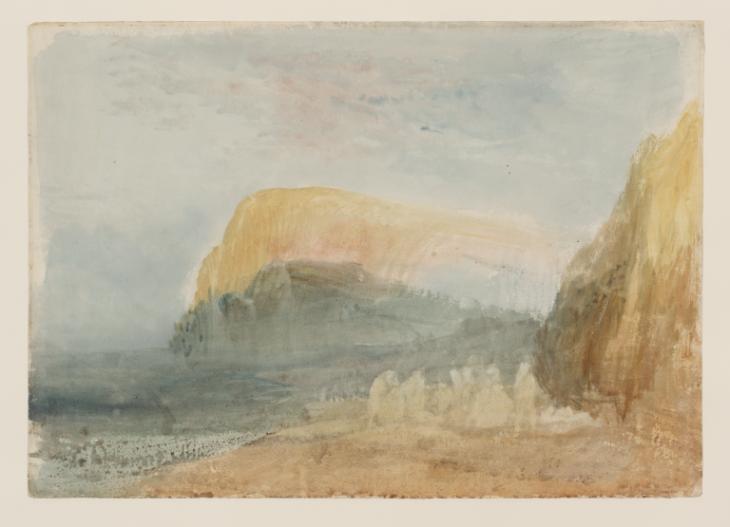Joseph Mallord William Turner Fish-Market, Hastings c.1824
Joseph Mallord William Turner,
Fish-Market, Hastings
c.1824
Joseph Mallord William Turner 1775–1851
Fish-Market, Hastings c.1824
D25500
Turner Bequest CCLXIII 376
Turner Bequest CCLXIII 376
Watercolour on white wove paper, 489 x 687 mm
Watermark ‘J Whatman | 1816’
Stamped in black ‘CCLXIII 376’ bottom right
Watermark ‘J Whatman | 1816’
Stamped in black ‘CCLXIII 376’ bottom right
Accepted by the nation as part of the Turner Bequest 1856
Exhibition history
1931
Display of Watercolours from the Turner Bequest, lent from the British Museum, National Gallery, Millbank (Tate Gallery), London 1931–March 1934 (no catalogue).
1989
Summer Miscellany: Watercolours from the Turner Bequest, Tate Gallery, London, July–September 1989 (no catalogue, as ‘Study for “Fish Market – Hastings”’).
2013
Turner’s Sussex, Petworth House, Sussex, January–March 2013 (20, as ‘Fish-Market, Hastings; Preparatory Study’, c.1824).
References
1820
A.J. Finberg, A Complete Inventory of the Drawings of the Turner Bequest, London 1909, vol.II, p.844, CCLXIII 376, as ‘Figures, with distant mountains’, c.1820–30.
1992
Ian Warrell in Martin Butlin (ed.), Hiroya Sugimura, Warrell and others, Sun, Wind and Rain: The Awakening of British Landscape Painting, exhibition catalogue, Tochigi Prefectural Museum of Arts, Utsonimiya 1992, p.228 under no.70.
1994
Ian Warrell, ‘Salerooms Report’, Turner Society News, no.68, December 1994, p.7.
1997
Eric Shanes, Turner’s Watercolour Explorations 1810–1842, exhibition catalogue, Tate Gallery, London 1997, p.99 Appendix I ‘Marine Views Series’.
1824
Andrew Loukes, Turner’s Sussex, exhibition catalogue, Petworth House, Sussex 2013, p.19 no.20, as ‘Fish-Market, Hastings; Preparatory Study’, c.1824.
Described by Finberg as a figure scene with ‘distant mountains’,1 this ‘colour beginning’ was first presented in a general 1989 Tate display of Turner’s watercolours selected by Robert Upstone2 as relating to the large watercolour Fish-Market, Hastings of 1824 (Hastings Museum and Art Gallery).3 The finished design was exhibited at the engraver and publisher W.B. Cooke’s gallery in 1824 (21, as ‘Fish-Market, Hastings’),4 and has been associated with Cooke’s short-lived Marine Views print project (see the Introduction to this section).
Once recognised, the relationship with the completed composition is clear, as the fall of the early morning light westwards from behind the viewer is similar, and the crowded beach scene is prefigured by the ghostly silhouettes of the group in the foreground here. They would be developed to comprise a particularly picturesque assortment of characters, with figures in exotic Greek costumes alluding to the contemporary Greek War of Independence.5
Among frequent maritime and coastal subjects, the theme developed here was a longstanding if occasional one for Turner (including some earlier treatments associated with the same Sussex location) in paintings such as Fishmarket on the Beach of about 1802–4 (currently untraced),6 Sun Rising through Vapour; Fishermen Cleaning and Selling Fish, exhibited in 1807 (Turner Bequest, National Gallery, London),7 and Fishmarket on the Sands – Hastings?, exhibited in 1810 (Nelson-Atkins Museum of Art, Kansas City, Missouri),8 as well as watercolours including Fishmarket on the Sands, ?Hastings of 1810 (currently untraced),9 and Fish Market on the Sands of as late as about 1840 (private collection).10 See also Sunset: A Fish Market on the Beach of about 1835, probably made as an illustration (Tate D36159; Turner Bequest CCCLXIV 302).
Acknowledged in Shanes 1997, p.99; see also Warrell 1992, p.228, Warrell 1994, p.7, and Loukes 2013, p.19.
Andrew Wilton, J.M.W. Turner: His Life and Work, Fribourg 1979, p.358 no.510, as ‘Hastings: fish-market on the sands’, untraced; Eric Shanes, Turner’s England 1810–38, London 1990, pp.124–5 no.97, reproduced in colour.
Alexander J. Finberg, The Life of J.M.W. Turner, R.A. Second Edition, Revised, with a Supplement, by Hilda F. Finberg, revised ed., Oxford 1961, p.485 no.291; see also Shanes 1990, pp.12, 281 note 49.
Technical notes:
The figures were perhaps initially reserved and worked over, or lifted out of the washes. There appears to have been some use of a stopping-out gum or varnish at the bottom left to resist the washes at the waterline and create a speckled effect of foaming surf.
Verso:
Blank; laid down.
Matthew Imms
July 2016
How to cite
Matthew Imms, ‘Fish-Market, Hastings c.1824 by Joseph Mallord William Turner’, catalogue entry, July 2016, in David Blayney Brown (ed.), J.M.W. Turner: Sketchbooks, Drawings and Watercolours, Tate Research Publication, February 2017, https://www

